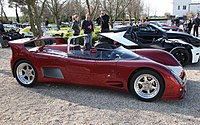|
Ultima Sport
Ultima Sport and Ultima Spyder is a supercar built by (then) kit-car manufacturers Ultima Sports Ltd. They are of a can-am design, with GRP bodywork set atop a bespoke chassis meant to accommodate a variety of engines from four to eight cylinders, or rotaries.[10] The design is of a mid-engined, rear wheel drive layout, with a tubular steel space frame chassis.[11] Originally meant as a kit car, Ultima began producing its first turn-key examples during the production run of the Sports/Spyder (the first such car being completed in 1993). HistoryThe Ultima Sport and its roadster derivative, the Ultima Spyder, were built from 1992 to 1999. The body styles were carried over largely unchanged for the succeeding Ultima GTR and Ultima Can-Am (roadster) models. The Sport, sometimes referred to as the Mk4 in company literature, followed on the Mk1 (1983), the Mk2 (1984), and the Mk3 (1989). The Mk2 was based on the Mk1 but with new suspension and better brakes, while the Mk3 received a new body.[12] Ted Marlow and Richard Marlow bought the rights to the car in 1992 and started building a revised model called the Ultima Sport.[12] Two examples of the earlier Mk3 had been used by McLaren in testing their upcoming F1 supercar; one to test the gearbox and central seating position ("Albert", chassis number 12) and the other car to test the BMW V12 engine and ancillaries ("Edward", number 13).[13] This was frequently mentioned in Ultima's company literature and period reviews.[10] The Ultima Sport used a developed version of the Mk3 bodywork, with larger headlamp openings which held three lights rather than the single units of the Mk3. A large rear spoiler, incorporated into the rear bodywork, became an available option in 1993, while power assisted brakes only became available in 1997.[11] The Spyder was new; this roadster variant offered a cut-down windshield and minimal protection from the elements. Originally introduced in 1993, it was first intended as a lower-cost example and Ultima expected buyers to opt for the Rover V8 and a Renault transaxle; customer demand, however, meant that Chevrolet small-block V8s were typically fitted instead. While a variety of engines could be fitted, in latter years Chevrolet's 5.7-litre small-block V8 became dominant. For buyers of the fully built-up models, the choice of engine was restricted to this engine, in three grades of performance with either 345, 430, or 500 hp (254, 316, or 368 kW) depending on the state of tune.[11] The chassis was designed to hold as much as 1,000 bhp (750 kW; 1,000 PS), however no version actually came with that much power.[14][15] EnginesThe Ultima Spyder would launch in 1993 initially as a softer version of the Sport, coming with a smaller 3.5-litre Rover V8, instead of the 5.7-litre Chevrolet small-block V8, but do to customer demand, the Spyder would be fit with the Chevrolet small-block V8 in 1994. In 1995, Ultima would produce a prototype Ultima Sport made entirely of Carbon-fiber, knocking the weight down to 600 kg (1,300 lb), and this would be far to expensive to produce, and Carbon-fiber would be shelved until the Ultima RS. For 1995, Ultima would produce a new engine mount system designed specifically for Rotary engines, but this would be an unpopular option, with less then 30 being made with this option from factory. There would not be an official Inline 4 option from factory, but a few would be fitted with them aftermarket. The 5.7 would be tuned for 345 bhp (350 PS; 257 kW), as they were unmodified Crate engines. The Rover V8s would be standard surplus purchases, with only a new exhaust system, would produce 230 bhp (230 PS; 170 kW). The Renault PRV V6 Turbocharged engine would produce 311 bhp (315 PS; 232 kW), but that would be in a standard tune, and with upping the boost, you could easily produce as much as 400 bhp (410 PS; 300 kW). [16][17][18]
References
External linksWikimedia Commons has media related to Ultima Sport. Wikimedia Commons has media related to Ultima Spyder. Information related to Ultima Sport |
||||||||||||||||||||||||||||||||||||||||||||||||


